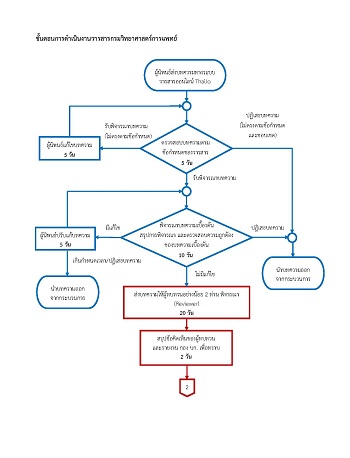การพัฒนาผลิตภัณฑ์ต้นแบบแบคทีเรียกำจัดลูกน้ำยุง สูตรอัดเม็ดและประสิทธิภาพการใช้เพื่อควบคุมยุงรำคาญชนิดคิวเล็กซ์ ควินเควฟาสซิเอตัส สายพันธุ์ธรรมชาติพื้นที่ชายแดนไทย
คำสำคัญ:
บาซิลลัส ทูริงเยนซิส อิสราเอลเลนสิส (บีทีไอ), บาซิลลัส สเฟียริคัส (บีเอส), เทมีฟอส, ยุงรำคาญ, แผนที่ระบบสารสนเทศภูมิศาสตร์บทคัดย่อ
แบคทีเรียกำจัดลูกน้ำยุงถูกนำมาใช้ควบคุมโรคที่นำโดยพาหะจากปัญหาการดื้อต่อสารเคมี แบคทีเรียบาซิลลัส ทูริงเยนซิส อิสราเอลเลนสิส (บีทีไอ) และบาซิลลัส สเฟียริคัส (บีเอส) มีราคาแพงและบางผลิตภัณฑ์ไม่มีประสิทธิภาพเพียงพอ การศึกษาครั้งนี้ได้นำแบคทีเรียบีทีไอผงแห้งที่ผลิตขึ้น มีการทดสอบประสิทธิภาพและรายงานผลไปแล้ว มาต่อยอดเป็นผลิตภัณฑ์สูตรอัดเม็ด มาทดสอบประสิทธิภาพและความคงทนกับลูกน้ำยุงลายบ้าน จากนั้นนำไปทดสอบด้านความต้านทานของลูกน้ำยุงรำคาญชนิดคิวเล็กซ์ ควินเควฟาสซิเอตัส สายพันธุ์พื้นที่ชายแดนไทยด้านประเทศเมียนมาร์ ลาว และกัมพูชา ผลการศึกษาได้ผลิตภัณฑ์บีทีไอสูตรอัดเม็ดค่าความแรง 2,150 ITU/mg มีความคงทนควบคุมลูกน้ำยุงลายได้ร้อยละ 100 เป็นเวลา 28 วัน การทดสอบกับลูกน้ำยุงรำคาญพื้นที่ไทย เมียนมาร์ ลาว และกัมพูชา มีความต้านทานอยู่ในช่วง 0.36-1.21, 0.72-1.20 และ 0.92-1.39 เท่า เมื่อเปรียบเทียบกับลูกน้ำสายพันธุ์มาตรฐาน และเพื่อให้ได้ข้อมูลที่ครบถ้วน ได้ทดสอบความต้านทานของลูกน้ำยุงรำคาญต่อแบคทีเรียบีเอสแบบผงแห้งที่ผลิตขึ้นและเทมีฟอสควบคู่กัน พบว่าลูกน้ำยุงรำคาญพื้นที่ชายแดนไทยทั้ง 3 ด้าน มีค่าความต้านทานต่อแบคทีเรียบีเอสอยู่ในช่วง 0.87-2.66, 1.99-3.17 และ 3.50-7.03 ต่อเทมีฟอส 0.47-3.01, 1.04-1.86 และ 1.07-2.45 เท่า ตามลำดับ ซึ่งแสดงผลเป็นแผนที่ระบบสารสนเทศภูมิศาสตร์
เอกสารอ้างอิง
WHO. Bacillus thuringiensis israelensis (Bti) in drinking-water, background document for development of WHO guidelines for drinking-water quality. Geneva: World Health Organization; 2009.
สำนักระบาดวิทยา. โรคเท้าช้าง. ใน: สรุปรายงานการเฝ้าระวังโรค ประจำปี 2557. นนทบุรี: กรมควบคุมโรค กระทรวงสาธารณสุข; 2558. หน้า 41-42.
สำนักระบาดวิทยา. โรคเท้าช้าง. ใน: สรุปรายงานการเฝ้าระวังโรค ประจำปี 2558. นนทบุรี: กรมควบคุมโรค กระทรวงสาธารณสุข; 2559. หน้า 45-46.
สำนักระบาดวิทยา. โรคเท้าช้าง. ใน: สรุปรายงานการเฝ้าระวังโรค ประจำปี 2559. นนทบุรี: กรมควบคุมโรค กระทรวงสาธารณสุข; 2560. หน้า 45-46.
Triteeraprapab S, Kanjanopas K, Suwannadabba S, Sangprakarn S, Poovorawan Y, Scott AL. Transmission of the nocturnal periodic strain of Wuchereria bancrofti by Culex quinquefasciatus: establishing the potential for urban filariasis in Thailand. Epidemiol Infect 2000; 125(1): 207-12.
Chansang U, Methawanitpong N, Saraprug D, Phetsuwan P, Ponsuwan N, Wiriyasaranont P. Development of larvicidal Bacillus thuringiensis var. israelensis by the Thai NIH and its comparison to Bacillus sphaericus and temephos in a selection experiment with the mosquito Culex quinquefasciatus. Int J Appl Microbiol Biotechnol Res 2020; 8(5): 58-65.
Dulmage HT, Correa JA, Gallegos-Morales G. Potential for improved formulation of Bacillus thuringiensis israelensis through standardization and fermentation development. In: de Barjac H, Sutherland DJ, editors. Bacterial control of mosquitoes and black flies. London: Rutgers University Press, 1990. p. 110-133.
Racloz V, Ramsey R, Tong S, Hu W. Surveillance of dengue fever virus: a review of epidemiological models and early warning systems. PLoS Negl Trop Dis 2012; 6(5): e1648. 9 pages.
Chowanadisai L, Methawanitphong N, U-mai N. Effectiveness of bacterial larvicide products from Thai strain Bacillus thuringiensis subsp. israelensis. In: Ngo DB, Akhuest RJ, Dean DH, editors. Biotechnology of Bacillus thuringiensis. Hanoi: Science and Technic Publishing House 2005. p. 365-382.
Buchanan RE, Gibbons NE, editors. Bergey’s manual of determinative bacteriology. 8th ed. Baltimore: Williams & Wilkins; 1974.
WHO. Bioassay method for the titration of Bacillus sphaericus preparations with RB 80 standard. In: Informal consultations on the development of Bacillus sphaericus as a microbial larvicide. Geneva: World Health Organization; 1985. p. 20-21.
WHO. Instruction for determining the susceptibility or resistance of mosquito larvae to insecticides. Geneva: World Health Organization; 1981.
Kahindi SC, Muriu S, Derua YA, Wang X, Zhou G, Lee MC, et al. Efficacy and persistence of long-lasting microbial larvicides against malaria vectors in western Kenya highlands. Parasit Vectors [serial online] 2018. Jul [cited 2020 Jun 22]; 11(1): [10 screens]. Available from: URL: https://www.ncbi.nlm.nih.gov/pmc/articles/PMC6069807.
Dunford JC, Stoops CA, Estep AS, Britch SC, Richardson AG, Walker TW, et al. SR450 and Superhawk XP applications of Bacillus thuringiensis israelensis against Culex quinquefasciatus. J Am Mosq Control Assoc 2014; 30(3): 191-8.
Triteeraprapab S, Nuchprayoon I, Porksakorn C, Poovorawan Y, Scott AL. High prevalence of Wuchereria bancrofti infection among Myanmar migrants in Thailand. Ann Trop Med Parasitol 2001; 95(5): 535-8.
Su T, Mulla MS. Field evaluation of new water-dispersible granular formulations of Bacillus thuringiensis ssp. israelensis and Bacillus sphaericus against Culex mosquitoes in microcosms. J Am Mosq Control Assoc 1999; 15(3): 356-65.
Zahiri NS, Su T, Mulla MS. Strategies for the management of resistance in mosquitoes to the microbial control agent Bacillus sphaericus. J Med Entomol 2002; 39(3): 513-20.
Tabbabi A, Daaboub J, Laamari A, Cheikh RB, Feriani M, Boubaker C, et al. Evaluation of resistance to temephos insecticide in Culex pipiens pipiens larvae collected from three districts of Tunisia. Afr Health Sci 2019; 19(1): 1361-7.
Xu Z, Bambrick H, Yakob L, Devine G, Lu J, Frentiu FD, et al. Spatiotemporal patterns and climatic drivers of severe dengue in Thailand. Sci Total Environ 2019; 656: 889-901.
วัชรพงษ์ แสงนิล, จารุวรรณ์ วงบุตดี. การประยุกต์ใช้ระบบสารสนเทศภูมิศาสตร์ เพื่อจำแนกพื้นที่เสี่ยงต่ออุบัติการณ์โรคมาลาเรียในเขตพื้นที่ชายแดงไทย-ลาว-กมั พูชา จังหวดั ศรีสะเกษ และจังหวัดอุบลราชธานี. วารสารสาธารณสุขศาสตร์ 2557; 44(3): 260-72.




